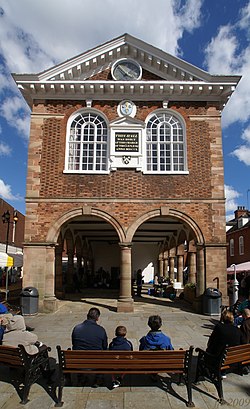Tamworth Town Hall
| Tamworth Town Hall | |
|
Warwickshire | |
|---|---|
 Tamworth Town Hall | |
| Location | |
| Grid reference: | SK20710397 |
| Location: | 52°37’59"N, 1°41’43"W |
| Town: | Tamworth |
| History | |
| Address: | Market Street |
| Built 1701 | |
| By: | William Gilkes |
| Neoclassical | |
| Information | |
Tamworth Town Hall is an elegant early eighteenth century municipal building in Market Street in Tamworth, and town on the border of Warwickshire with Staffordshire. The town hall (which stands just on the Warwickshire side of the border running through the town), was the meeting place of Tamworth's borough corporation, and a a society 'assembly room'. Tioday if not used as a civil headquarters, it is maintained by the local council.
The town hall is a Grade II* listed building.[1]
History
The first town hall was a medieval structure in Market Street which had vaults under the Butter Market.[2] In the late 17th century the local member of parliament, Thomas Guy, who had already funded some local alms-houses decided to finance a new town hall for the town on the same site.[2]
The new building, which was designed in the neoclassical style almost certainly by William Gilkes, was built in red brick with stone dressings at a cost of £1,000 and completed in 1701.[2] The structure consisted of arcading on the ground floor so that markets could be held and 18 Doric order columns which supported a double-cube assembly hall on the first floor.[2] The western elevation featured two arches with archivolts and keystones on the ground floor, two round headed windows on the first floor and a cornice with modillions as well as a pediment above.[1] A plaque was erected between the two windows on the first floor with the words "This hall was built at the charge of Thos. Guy Esq. Anno MDCCI" (1701).[1] A shield bearing Guy's coat of arms was installed below the plaque while the town's coat of arms was erected above it.[1] There was a cupola with a weather vane at roof level.[1] The first meeting of bailiffs and burgesses in the new town hall took place on 20 July 1702.[3]

The building was extended eastward with two extra rooms in 1771[4] and a more substantial extension to the east was completed in 1811.[4] A clock was installed in the pediment on the western front as a gift from the then owner of Tamworth Castle, John Robbins, in 1812.[5] The local member of parliament and future Prime Minister, Sir Robert Peel, during campaigning the forthcoming general election, read his manifesto to the local people at the town hall in December 1834.[5] Peel's basic message was that the Conservative Party "would reform to survive".[6] The area became a municipal borough with the town hall as it headquarters in 1834.[7]
In 1845, a substantial rebuilding of the structure took place.[1] A bronze statue by Matthew Noble depicting Peel standing on an ashlar pedestal was unveiled outside the town hall in 1853.[8] A horse-drawn fire engine was installed in the arcaded area on the ground floor in 1880[3] and further works were carried out to create a town clerk's office in the late 18th century and a mayor's parlour in the early 19th century.[2] The main room on the first floor was converted for use as a council chamber in 1934.[3]
The town hall remained the local seat of government after the enlarged Tamworth Borough Council was formed in 1972. It continued to serve as its meeting place until Burlington House in Lichfield Street, a tower block which had been built in 1960,[9] was acquired by the council and renamed "Marmion House", after the local Marmion family who were the owners of Tamworth Castle from c.1100 to 1294.[3][10]
| ("Wikimedia Commons" has material about Tamworth Town Hall) |
References
- ↑ 1.0 1.1 1.2 1.3 1.4 1.5 National Heritage List 1293012: Town Hall (Grade II* listing)
- ↑ 2.0 2.1 2.2 2.3 2.4 Guy's Town Hall: Tamworth Heritage Trust
- ↑ 3.0 3.1 3.2 3.3 "Significant Dates in the History of Tamworth". http://www.tamworthcastlefriends.org/page7.html.
- ↑ 4.0 4.1 "Thomas Guy's Town Hall and Almshouses". Visit Tamworth. http://www.visittamworth.co.uk/sites/default/files/inline-images/Thomas-Guys-Leaflet.pdf. Retrieved 10 February 2021.
- ↑ 5.0 5.1 "Want to pop the question in the historic Tamworth Town Hall?". Tamworth Council. https://www.tamworth.gov.uk/Town-Hall-proposals. Retrieved 10 February 2021.
- ↑ Gash, Norman (1972). Sir Robert Peel: The Life of Sir Robert Peel after 1830. Prentice Hall Press. ISBN 978-0582502048.
- ↑ "Tamworth MB". Vision of Britain. https://www.visionofbritain.org.uk/unit/10055258. Retrieved 10 February 2021.
- ↑ National Heritage List 1196996: Statue of Sir Robert Peel (Grade II listing)
- ↑ "Marmion House, Tamworth". Realla. https://www.realla.co.uk/details/15939159. Retrieved 10 February 2021.
- ↑ Comerford, Patrick (21 May 2019). "Tamworth's Town Hall has survived". http://www.patrickcomerford.com/2019/05/tamworths-town-hall-has-survived.html.
